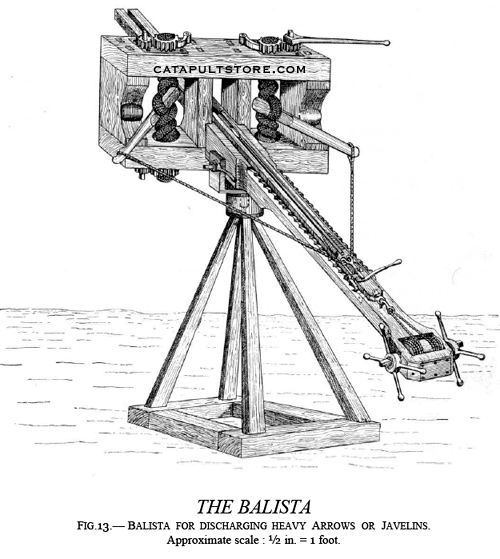
THE BALLISTA
FIG.13. - BALLISTA FOR DISCHARGING HEAVY ARROWS OR JAVELINS.
Approximate scale : ½in. = 1 foot.
This engine is here shown ready for discharge with its bow-string drawn
to its full extent by the windlass. The heavy iron-tipped arrow rests in
the shallow wooden trough or groove which travels along the stock.
The trough has a strip of wood, in the form of a keel, fixed beneath
it. This keel travels to or fro in a dove-tailed slot cut along the upper
surface of the stock for the greater part of its length. ( F, fig. 14.)
The arrow is laid in the trough before the bow-string is stretched.
(A, B, fig. 14.)
The ballista is made ready for use by turning the windlass. The windlass
pulls back the sliding trough, and the arrow resting in it, along the stock
of the engine, till the bow-string is at its proper tension for discharging
the projectile.
( Fig.13.)
As the trough and the arrow are drawn back together, the arrow can be
safely laid in position before the engine is prepared for action. The catch
for holding the bow-string, and the trigger for releasing it, are fixed
to the solid after end of the wooden trough. ( Fig. 14. )
The two ratchets at the sides of the after end of the trough travel
over and engage, as they pass along, the metal cogs fixed on either side
of the stock. ( Fig.14.)1
By this arrangement the trough can be securely retained, in transit,
at any point between the one it started from and the one it attains when
drawn back to its full extent by the windlass. As the lock and trigger
of the ballista are fixed to the after end of the sliding trough ( fig.
14. ), it will be realized that the arrow could be discharged at any moment
required in warfare, whether the bow-string was fully or only partially
stretched.
In this respect the ballista differed from the crossbow,
which it somewhat resembled, as in a crossbow
the bow-string cannot be set free by the trigger at an intermediate point,
but only when it is drawn to the lock of the weapon. It will be seen that
the ballista derives its power from two arms ; each with its separate skein
of cord and pair of winches. These parts of the ballista are the same in
their action and mechanism as those of the catapult.
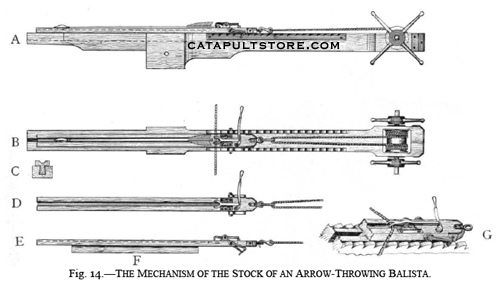
FIG. 14.- THE MECHANISM OF THE STOCK OF AN ARROW THROWING BALLISTA.
A. Side view of the stock, with the arrow in the sliding trough before
the bow-string is stretched.
B. Surface view of the stock, with the arrow in the sliding trough before
the bow-string is stretched.
C. Section of the fore-end of the stock, and of the trough which slides
in and along it.
1 When the bow-string has been released and
the arrow discharged, the ratchets are lifted clear of the cogs on the
stock of the engine. This allows the trough to be slid forward to its first
position as shown in A, B, Fig. 14. It is then ready to be drawn back again
for the next shot.
D. Surface view of the trough, with the trigger and catch for the bowstring.
E. Side view, showing the keel (F) which slides along the slot cut in
the surface of the stock as the trough is drawn back by the windlass.
G. Enlarged view of the solid end of the trough. This sketch shows the
catch for the bow-string, the trigger which sets it free, the ratchets
which engage the cogs on the sides of the stock, and the slot cut in the
stock for the dove-tailed
keel of the trough to travel in.
Ballistas were constructed of different sizes for the various purposes
of siege and field warfare. The smallest of these engines was not much
larger than a heavy crossbow, though it more than equalled the latter in
power and range.
The small ballistas were chiefly used for shooting through loopholes
and from battlemented walls at an enemy assaulting with scaling ladders
and movable towers.
The largest had arms of 3 ft. to 4 ft. in length, and skeins of twisted
sinew of 6 in. to 8 in. in diameter.
Judging from models I have made and carefully experimented with, it
is certain that the more powerful ballistas of the ancients could cast
arrows, or rather feathered javelins, of from 5 to 6 lbs. weight, to a
range of from 450 to 500 yards.
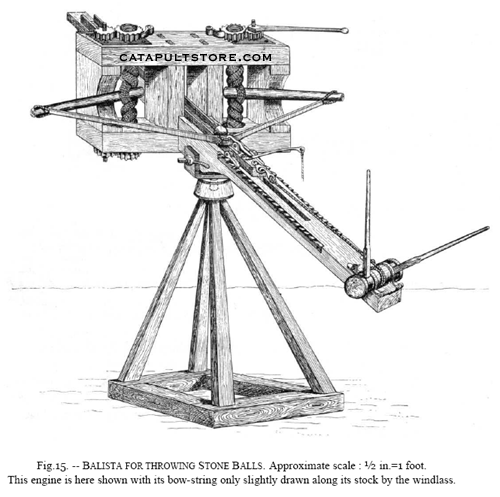
Fig.15. - BALlISTA FOR THROWING STONE BALLS. Approximate scale :
½in.=1 foot.
This engine is here shown with its bow-string only slightly drawn
along its stock by the windlass.
It will be seen that this engine is almost identical in construction
with the one last described. (Fig.13.)
The difference is that it propelled a stone ball instead of a large
arrow. The ball was driven along a square wooden trough, one-third of the
diameter of the ball being enclosed by the sides of the trough so as to
keep the missile in true direction after the bow-string was released.
The bow-string was in the form of a broad band, with an enlargement
at its center against which the ball rested.
The description given of the mechanism and management of the engine
for throwing arrows can be applied to the construction and manipulation
of this form of ballista, which was also made of large and small dimensions.
Small engines with arms about 2 ft. in length and skeins of cord about
4 in. in diameter, such as those I have built for experiment, will send
a stone ball, 1 lbs. in weight, from 300 to 350 yards. There is little
doubt that the large stone throwing ballista of the Greeks and Romans was
able to project a circular stone, of 6 to 8 lbs. weight, to a distance
of from 450 to 500 yards.1
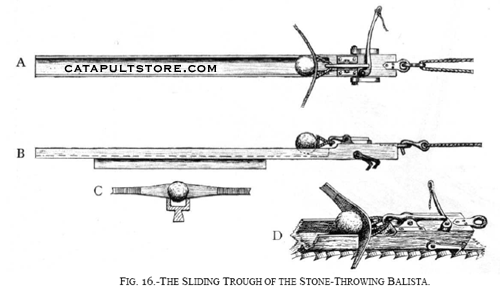
FIG. 16. - THE SLIDING TROUGH OF THE STONE THROWING BALLISTA.
A. Surface view, with the stone in position.
B. Side view, with stone in position.
C. Front view of the stone as it rests in the trough against the enlarged
center of the bow-string.
D. Enlarged view of the solid end of the sliding trough. This sketch
shows the ball in position against the bow-string ; the catch bolding the
loop of the bowstring, and the pivoted trigger which, when pulled, releases
the catch. One of the
pair of ratchets which engage the cogs on the sides of the stock, as
the trough is drawn back by the windlass to make ready the engine, is also
shown. The trough has a keel to it, and slides to or fro along the stock
in the same manner as in the arrow throwing ballista. (Fig.13.)
Compare with figs. 13 and 14, for further explanation of details.
1 The balls used by the ancients in their catapults
and ballistas were often formed of heavy pebbles enclosed in baked clay,
the reason being that balls made in this way shattered on falling and hence
could not be shot back by the engines of the enemy. The ballistas for throwing
arrows, and those employed for casting stones, were fitted with axles and
wheels when constructed for use in field warfare.
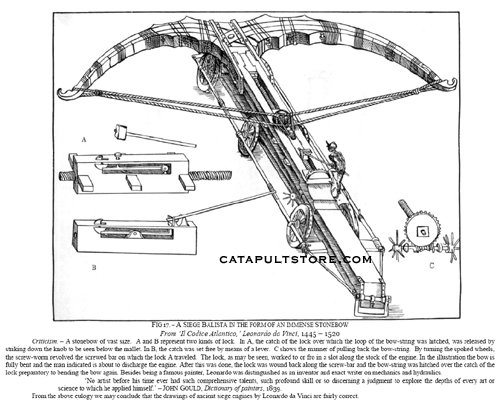
FIG 17. - A SIEGE BALLISTA IN THE FORM OF AN IMMENSE STONEBOW
From Il Codice Atlantico, Leonardo
da Vinci, 1445-1520
Criticism. "A stonebow of vast size. A and B represent
two kinds of lock. In A, the catch of the lock over which the loop of the
bow-string was hitched, was released by striking down the knob to be seen
below the mallet. In B, the catch was set free by means of a lever. C shows
the manner of pulling back the bow-string. By turning the spoked wheels,
the screw worm revolved the screwed bar on which the lock A traveled. The
lock, as may be seen, worked to or fro in a slot along the stock of the
engine. In the illustration the bow is fully bent and the man indicated
is about to discharge the engine. After this was done, the lock was wound
back along the scrubber and the bow-string was hitched over the catch of
the lock preparatory to bending the bow again. Besides being a famous painter,
Leonardo
was distinguished as an inventor and exact writer on mechanics and hydraulics.
No artist before his time ever had such comprehensive
talents, such profound skill or so discerning a judgment to explore the
depths of every art or science to which he applied himself. JOHN GOULD, Dictionary of painters, 1839.
From the above eulogy we may conclude that the drawings of ancient
siege engines by Leonardo
da Vinci are fairly correct.
Ballista - Build a Ballista - Ballista Design
Plans - Roman Ballista Catapult
Roman stone throwing and arrow throwing torsion
ballista |